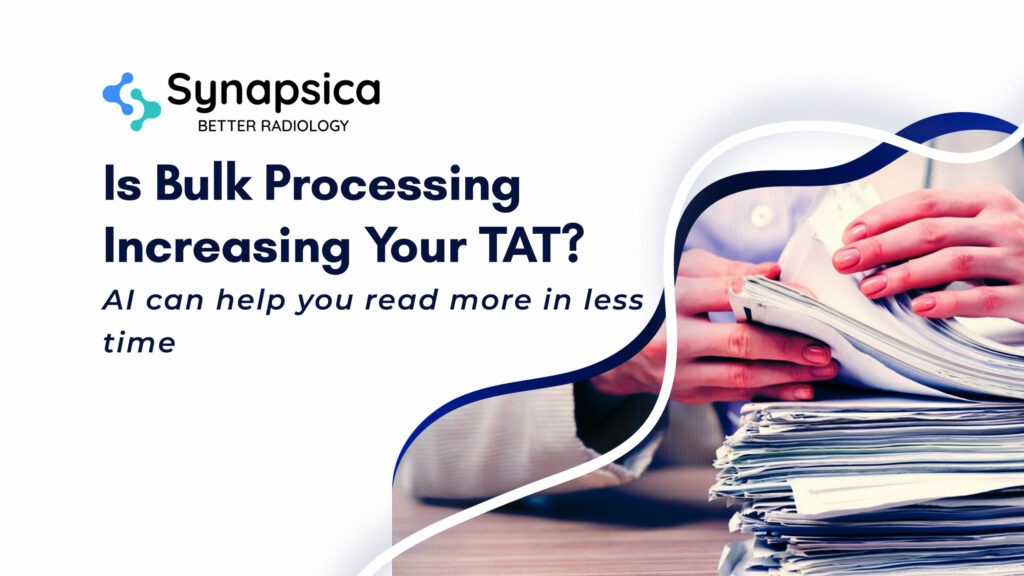
TAT or turnaround time is no longer a concern for just patients and physicians, but also for imaging facilities. As it turns out, even diagnostic centers operate under a lot of pressure to reduce their TAT.
Shortening the reporting times of cases is beneficial for diagnostic centers in numerous ways.
1. Why should imaging facilities control or reduce their Turnaround time?
1.1. Credits the daily revenue
Optimizing or reducing the TAT on an operational level gives credit to your daily revenue and improves your monthly revenue cycle.
1.2. Increases your credibility
Your credibility is directly proportional to the report turnaround time. The faster and more reliable the report TAT, the more credibility you will get from clients, referrals, patients, and business partners.
1.3. Amplifies monthly throughput
Lesser TAT leads to an increase in the number of cases studied every day. This means your monthly throughput can dramatically increase within a short time.
1.4. Enables timely patient care
Above all, a shorter turnaround time allows physicians to take quick actions and provide timely care to the patient. In addition, reduced TAT also improves both physicians’ and patients’ experience with the imaging facility, and such tangible advantages boost your reputation and provide the opportunity to scale.
Most diagnostic centers and imaging service providers are aware of the benefits of controlled or reduced reporting turnaround time.
Yet, they struggle to reduce their TAT despite hiring skilled radiology professionals and installing costly imaging (MRI and CT) machines.
Why is it so?
2. Reasons why you have more turnaround time
2.1. Increasing imaging procedures creates more workload
The healthcare industry is increasingly dependent on medical imaging like never before. Radiologists are now reading 78% more cases than what they were reading in 2008. Undoubtedly increasing imaging studies mean more business for diagnostic centers and imaging facilities. But the key challenge is the dismal rate at which radiologist shortage is increasing.
Due to the fast-increasing radiologist shortage, diagnostic centers are unable to handle the increase in everyday caseload.
2.2. Lack of prioritization
“The most import factor that inhibits efficient turnaround time is poor study prioritization” – says Dr. Peter Sachs, MD, a radiology professor at UCH (University of Colorado Hospital).
Unless the radiologist understands the time criticality of the study, he or she is not likely to study the case or produce a report promptly. Dr. Sachs also added that identifying the importance of cases helps in reducing the TAT.
2.3. Multiple injury cases consist of hundreds of images to read
In multiple injury cases, radiologists have to read through hundreds of images to accurately diagnose the problems in the injured areas. For instance, traumatic patients can be sent with five to six CT scans at a time – CT Head, CT Cervical Spine, CT Thoracic Spine, CT Lumbar Spine, CT Abdomen or Pelvis, CT Chest, etc.
Reading more images at once for a single multiple injury case is time-consuming and leads to increased report turnaround time.
3. Read more in less time with AI
Applications of AI in radiology is the talk of the town recently. AI is not a new topic in radiology. It has been used in the form of CAD in radiology for years now. However, the technology is greatly evolved now than it was a decade ago and finds numerous applications in the field of medical imaging.
One of the most important applications of AI in radiology is it can enable diagnostic service providers to read more cases in less time. Or in other words, AI can help reduce or control TAT significantly.
Here’s how AI can help in reducing your TAT:
3.1. Automatic prioritization
Prioritization is critical. But, it is also an additional task that can be time-consuming. Training AI models to prioritize cases based on their criticality enables automation of the entire prioritization process. This saves radiologists from extra work and allows them to immediately concentrate on critical cases.
3.2. Automates manual tasks to reduce the workload on radiologists
80% of reporting time in spine MRIs is spent on tasks that can be automated using AI. For instance, some of the manual day-to-day tasks that radiologists perform before eyeballing the image for deformities are sorting the images based on their quality, marking the morphological points, locating and labeling vertebrae, etc.
Automating these tasks avoids radiologists wasting their time on repetitive tasks and helps them focus more on the correlation between the symptoms and the findings from the image. This will help diagnostic centers improve the accuracy of diagnosis while reducing their reporting TAT.
3.3. Perform preliminary reads and generate reports
What makes AI more significant than any other technology breakthrough is that it can mimic human intelligence. In fact, AI has proven its value in numerous fields of healthcare like drug discovery, cancer diagnosis, patient triaging, etc.
In radiology, AI can do much more than image sorting, prioritizing cases, and labeling elements. It can study scans, x-rays, CT, and MRI just the way a radiologist would and generate reports without human intervention.
Even better, AI can perform quantitative imaging analysis of scans and generate objective reports, which can help significantly reduce diagnostic errors and misinterpretations.
AI has a much wider scope in radiology. Automating manual tasks and report generation is just the beginning. In fact, numerous health tech firms have made it their mission to unleash the full potential of AI in healthcare.
Synapsica is one such health tech that was founded with the mission to improve spine reading and reporting with AI. Synapsica has succeeded in building AI algorithms, Spindle and SpindleX, which are now commercially used by numerous health systems and diagnostic centers to automate the reading and reporting of spine MRIs and stress x-rays.
This 2-minute demo video will show you how you can improve your operational efficiency and reduce TAT, all at a cost lesser than hiring a new set of radiologists. Check now!